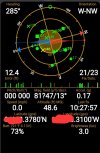THIS IS A VERY LONG POST... READ IT IN ITS ENTIRETY TO LEARN ABOUT HOW GPS ACCURACY VARIES DYNAMICALLY, AND HOW TO PLAN A MISSION WITH THE MOST ACCURACY POSSIBLE
____________________________________________
Waypoint coordinates will be no more precise than you experience with RTH without Precision Landing active (which uses the VPS cameras and Optical Flow to maneuver a precise touchdown within a few inches).
With an excellent configuration of satellites and a clear, unobstructed view of the sky, you can expect at best 3ft accuracy from consumer-grade GPS.
As such, getting within a meter of a waypoint's location is excellent, and you can't
expect better precision. Random chance may take you closer to the precise location on any particular run, but that's not reliably repeatable.
On android, I use an app called
GPS Status and Toolbox to determine things like current accuracy in my location. It calculates the DOP from the current satellite configuration, and converts this to an estimated accuracy. I've found it to be a pretty good indicator of what sort of GPS precision I can expect when I fly.
Right now, were I to fly and use simple GPS-based RTH, I would expect the drone to come back and land within a ~12 ft radius circle centered on the Home Point location:
View attachment 174767
Waypoint accuracy would be the same if I were to fly a mission right now.
Note the satellite locations and distribution in the sky (the little squares, circles, x's in the big horizon circle above). They are poorly distributed right now, hence the up to 12ft (average!) error.
If I needed the best possible accuracy, I could wait for a better distribution of sats, getting the error down as low as 3-4ft.
The positions and movement of the satellites is known and predictable (GPS wouldn't work otherwise). There are on line tools (
GNSS Mission Planning, and
Google it) that can be used to predict the error in the future at some date/time, so for planning a waypoint flight to be as accurate as possible, you can determine when to fly the mission and get the most accurate result.












